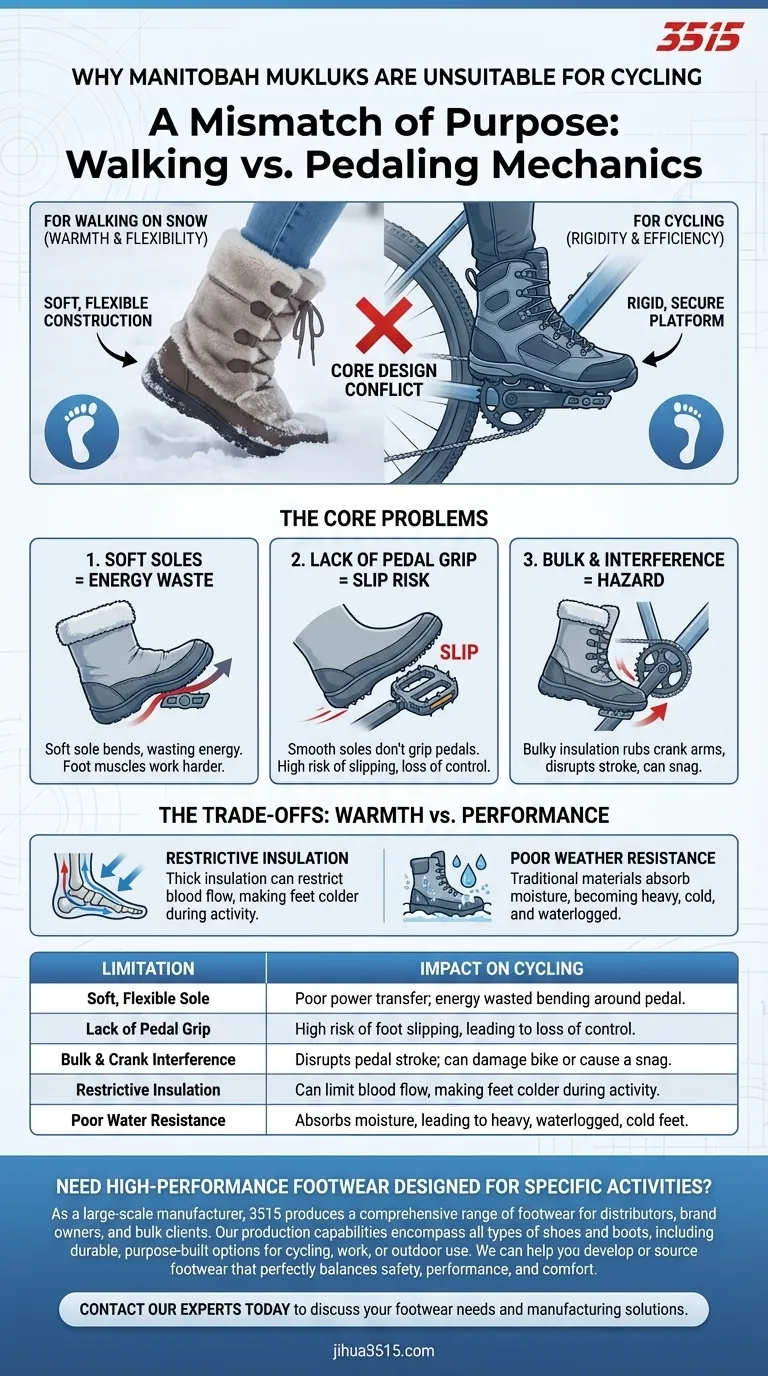Manitobah Mukluks are fundamentally unsuitable for cycling due to a core design conflict. Their soft, flexible construction, created for walking on snow, directly opposes the rigid, secure platform required for efficient and safe pedaling. While their insulation is excellent for walking, the overall design compromises power transfer, pedal grip, and safety when on a bicycle.
The central issue is a mismatch of purpose. Mukluks are engineered for warmth and flexibility while walking, whereas effective cycling footwear demands rigidity for power transfer, a secure connection to the pedal, and a streamlined design to avoid interfering with the bicycle's mechanics.

The Core Conflict: Walking vs. Pedaling Mechanics
The features that make Mukluks exceptional for traditional use become significant liabilities when applied to the biomechanics of cycling. The needs of a walker and a cyclist are mechanically opposite.
The Problem with Soft Soles
A Mukluk's sole is designed to be soft and flexible, allowing your foot to feel the ground and move naturally. On a bicycle pedal, this flexibility becomes a major inefficiency.
Instead of transferring power directly into the pedal stroke, a soft sole bends and sags around the pedal. This wastes a significant amount of your energy with every rotation, forcing your foot muscles to work harder to compensate.
Lack of Pedal Grip and Security
The soles of Mukluks are typically smooth or have patterns designed for traction on snow, not for gripping the metal or composite pins of a bicycle pedal.
This creates a high risk of your foot slipping, especially in wet or slushy conditions. A sudden loss of footing on a pedal can easily cause a loss of control, leading to a fall and potential injury.
Bulk and Crank Arm Interference
Mukluks are inherently bulky to accommodate thick insulation. This width often leads to the boot rubbing against the bicycle's crank arms as you pedal.
This interference disrupts a smooth pedal stroke, can damage both your boots and your bike, and at worst, could potentially snag, creating a serious safety hazard.
Understanding the Trade-offs: Warmth vs. Performance
While the goal of using Mukluks is warmth, their design is not optimized for warmth during athletic activity. This leads to several counterintuitive problems.
Insulation and Blood Flow
The thick, compressive insulation in a Mukluk can restrict blood flow to your feet when they are in the fixed position of cycling.
Proper circulation is the most critical factor in keeping your extremities warm. Cycling-specific winter boots use more advanced, less bulky insulation in targeted areas to maintain warmth without compromising blood flow or performance.
Inadequate Weather Resistance
Traditional suede and leather Mukluks are not waterproof. They absorb moisture from slush and snow, quickly becoming heavy, waterlogged, and intensely cold.
Effective winter cycling requires footwear that actively repels water. Once your feet get wet in the cold, no amount of insulation will keep them warm.
The Constraint of Fit
The lack of specialized sizing, such as double-wide options, can further compound these issues.
A fit that is too narrow will severely restrict circulation, accelerating the onset of cold feet and discomfort, regardless of the boot's insulation rating.
Making the Right Choice for Your Cycling Needs
To ensure safety, comfort, and efficiency, you must match your footwear to the specific demands of the activity.
- If your primary focus is a very short, casual ride in dry, cold weather: Mukluks may be passable for a few blocks, but you must remain acutely aware of the poor pedal grip and potential for your foot to slip.
- If your primary focus is regular winter commuting or trail riding: A pair of waterproof hiking boots with a semi-rigid sole is a far superior and safer choice than a soft-soled boot.
- If your primary focus is performance and warmth on long rides: There is no substitute for dedicated winter cycling boots, which are purpose-built with a stiff sole, weatherproofing, and optimized insulation.
Ultimately, selecting footwear designed for the specific biomechanical demands of cycling will always provide a safer, more comfortable, and more efficient ride.
Summary Table:
| Limitation | Impact on Cycling |
|---|---|
| Soft, Flexible Sole | Poor power transfer; energy wasted bending around pedal |
| Lack of Pedal Grip | High risk of foot slipping, leading to loss of control |
| Bulk & Crank Interference | Disrupts pedal stroke; can damage bike or cause a snag |
| Restrictive Insulation | Can limit blood flow, making feet colder during activity |
| Poor Water Resistance | Absorbs moisture, leading to heavy, waterlogged, cold feet |
Need high-performance footwear designed for specific activities?
As a large-scale manufacturer, 3515 produces a comprehensive range of footwear for distributors, brand owners, and bulk clients. Our production capabilities encompass all types of shoes and boots, including durable, purpose-built options for cycling, work, or outdoor use. We can help you develop or source footwear that perfectly balances safety, performance, and comfort.
Contact our experts today to discuss your footwear needs and manufacturing solutions.
Visual Guide

Related Products
- Premium KPU Athletic Safety Shoes for Wholesale
- Durable Rubber-Soled Utility Shoes for Wholesale & Custom Brand Manufacturing
- Wholesale Breathable Training Shoes Custom Athletic Footwear Manufacturer
- Wholesale Training Shoes with Dial Lacing System Custom OEM Manufacturing
- Wholesale Durable & Breathable Training Shoes for Custom Brands
People Also Ask
- What types of workplace hazards require protective footwear? Essential Guide for Workplace Safety
- What materials are used in the construction of these boots? A Guide to Velour Leather, Textile & PU Soles
- What are the conditions faced by employees in meatpacking and poultry slaughter plants? Navigating Pervasive Slip Hazards
- Why is expert help recommended when selecting safety shoes? Ensure Perfect Fit & Hazard Protection
- Why is slip resistance important in safety footwear? Prevent Costly Workplace Slips and Falls



















